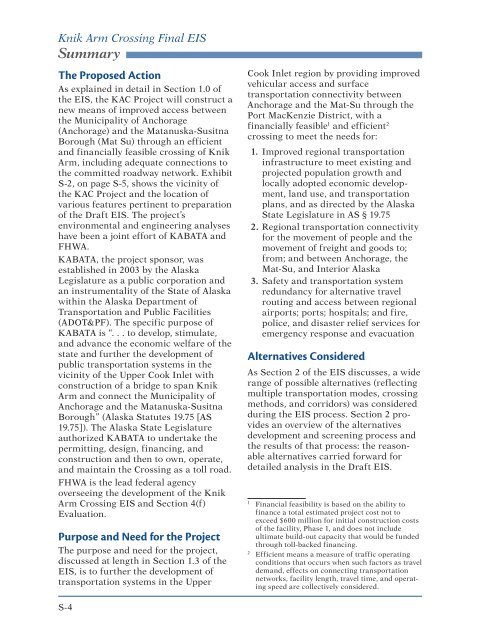FEIS Summary - Knik Arm Bridge and Toll Authority
FEIS Summary - Knik Arm Bridge and Toll Authority
FEIS Summary - Knik Arm Bridge and Toll Authority
Create successful ePaper yourself
Turn your PDF publications into a flip-book with our unique Google optimized e-Paper software.
<strong>Knik</strong> <strong>Arm</strong> Crossing Final EIS<br />
<strong>Summary</strong><br />
The Proposed Action<br />
As explained in detail in Section 1.0 of<br />
the EIS, the KAC Project will construct a<br />
new means of improved access between<br />
the Municipality of Anchorage<br />
(Anchorage) <strong>and</strong> the Matanuska-Susitna<br />
Borough (Mat Su) through an efficient<br />
<strong>and</strong> financially feasible crossing of <strong>Knik</strong><br />
<strong>Arm</strong>, including adequate connections to<br />
the committed roadway network. Exhibit<br />
S-2, on page S-5, shows the vicinity of<br />
the KAC Project <strong>and</strong> the location of<br />
various features pertinent to preparation<br />
of the Draft EIS. The project’s<br />
environmental <strong>and</strong> engineering analyses<br />
have been a joint effort of KABATA <strong>and</strong><br />
FHWA.<br />
KABATA, the project sponsor, was<br />
established in 2003 by the Alaska<br />
Legislature as a public corporation <strong>and</strong><br />
an instrumentality of the State of Alaska<br />
within the Alaska Department of<br />
Transportation <strong>and</strong> Public Facilities<br />
(ADOT&PF). The specific purpose of<br />
KABATA is “. . . to develop, stimulate,<br />
<strong>and</strong> advance the economic welfare of the<br />
state <strong>and</strong> further the development of<br />
public transportation systems in the<br />
vicinity of the Upper Cook Inlet with<br />
construction of a bridge to span <strong>Knik</strong><br />
<strong>Arm</strong> <strong>and</strong> connect the Municipality of<br />
Anchorage <strong>and</strong> the Matanuska-Susitna<br />
Borough” (Alaska Statutes 19.75 [AS<br />
19.75]). The Alaska State Legislature<br />
authorized KABATA to undertake the<br />
permitting, design, financing, <strong>and</strong><br />
construction <strong>and</strong> then to own, operate,<br />
<strong>and</strong> maintain the Crossing as a toll road.<br />
FHWA is the lead federal agency<br />
overseeing the development of the <strong>Knik</strong><br />
<strong>Arm</strong> Crossing EIS <strong>and</strong> Section 4(f)<br />
Evaluation.<br />
Purpose <strong>and</strong> Need for the Project<br />
The purpose <strong>and</strong> need for the project,<br />
discussed at length in Section 1.3 of the<br />
EIS, is to further the development of<br />
transportation systems in the Upper<br />
Cook Inlet region by providing improved<br />
vehicular access <strong>and</strong> surface<br />
transportation connectivity between<br />
Anchorage <strong>and</strong> the Mat-Su through the<br />
Port MacKenzie District, with a<br />
financially feasible 1 <strong>and</strong> efficient 2<br />
crossing to meet the needs for:<br />
1. Improved regional transportation<br />
infrastructure to meet existing <strong>and</strong><br />
projected population growth <strong>and</strong><br />
locally adopted economic development,<br />
l<strong>and</strong> use, <strong>and</strong> transportation<br />
plans, <strong>and</strong> as directed by the Alaska<br />
State Legislature in AS § 19.75<br />
2. Regional transportation connectivity<br />
for the movement of people <strong>and</strong> the<br />
movement of freight <strong>and</strong> goods to;<br />
from; <strong>and</strong> between Anchorage, the<br />
Mat-Su, <strong>and</strong> Interior Alaska<br />
3. Safety <strong>and</strong> transportation system<br />
redundancy for alternative travel<br />
routing <strong>and</strong> access between regional<br />
airports; ports; hospitals; <strong>and</strong> fire,<br />
police, <strong>and</strong> disaster relief services for<br />
emergency response <strong>and</strong> evacuation<br />
Alternatives Considered<br />
As Section 2 of the EIS discusses, a wide<br />
range of possible alternatives (reflecting<br />
multiple transportation modes, crossing<br />
methods, <strong>and</strong> corridors) was considered<br />
during the EIS process. Section 2 provides<br />
an overview of the alternatives<br />
development <strong>and</strong> screening process <strong>and</strong><br />
the results of that process: the reasonable<br />
alternatives carried forward for<br />
detailed analysis in the Draft EIS.<br />
1<br />
Financial feasibility is based on the ability to<br />
finance a total estimated project cost not to<br />
exceed $600 million for initial construction costs<br />
of the facility, Phase 1, <strong>and</strong> does not include<br />
ultimate build-out capacity that would be funded<br />
through toll-backed financing.<br />
2<br />
Efficient means a measure of traffic operating<br />
conditions that occurs when such factors as travel<br />
dem<strong>and</strong>, effects on connecting transportation<br />
networks, facility length, travel time, <strong>and</strong> operating<br />
speed are collectively considered.<br />
S-4
















